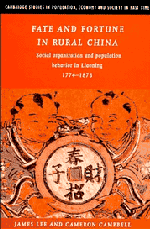Book contents
- Frontmatter
- Contents
- List of figures
- List of maps
- List of tables
- Acknowledgements
- PART 1 DAOYI VILLAGE
- PART 2 THE LIAONING DEMOGRAPHIC SYSTEM
- 4 Two types of positive check: infanticide and neglect
- 5 Two types of preventive check: nuptiality and fertility
- PART 3 HOUSEHOLD ORGANIZATION AND POPULATION BEHAVIOR
- PART 4 BANNER ORGANIZATION AND POPULATION BEHAVIOR
- EPILOGUE: PROSPECTS, IMPLICATIONS, AND COMPARISONS
- Appendices
- Glossary
- References
- Index
- Cambridge Studies in Population, Economy and Society in Past Time
5 - Two types of preventive check: nuptiality and fertility
Published online by Cambridge University Press: 20 October 2009
- Frontmatter
- Contents
- List of figures
- List of maps
- List of tables
- Acknowledgements
- PART 1 DAOYI VILLAGE
- PART 2 THE LIAONING DEMOGRAPHIC SYSTEM
- 4 Two types of positive check: infanticide and neglect
- 5 Two types of preventive check: nuptiality and fertility
- PART 3 HOUSEHOLD ORGANIZATION AND POPULATION BEHAVIOR
- PART 4 BANNER ORGANIZATION AND POPULATION BEHAVIOR
- EPILOGUE: PROSPECTS, IMPLICATIONS, AND COMPARISONS
- Appendices
- Glossary
- References
- Index
- Cambridge Studies in Population, Economy and Society in Past Time
Summary
Until recently it was widely accepted that fertility in late imperial China was neither constrained by nuptiality nor controlled by couples. On the one hand, the availability of resources from the extended family meant that young people could marry without regard to current economic conditions. Thus in contrast with Europe, fertility was not constrained by changes in the proportion married. On the other hand, under normal conditions, Chinese couples never attempted to control the number of their children, especially their sons, and practiced infanticide only in response to famine and extreme poverty. There have accordingly been very few detailed analyses of the specific circumstances under which Chinese parents may have deliberately controlled their fertility. As a result, a number of misperceptions have arisen regarding reproductive behavior in China before this century.
This chapter provides yet another set of evidence showing that the historical reality was much more complex than commonly assumed. Specifically we demonstrate that just as there were two types of positive check, there were also two types of preventive check, both before and after marriage. In section I, we analyze nuptiality to establish that, in Liaoning, opportunities for males to marry and father children were constrained by a shortage of single women, the result of both female infanticide and customary strictures against widow remarriage. In section II, we show that, within marriage, fertility was low by historical European standards, and that low rates were as much the result of restraint within marriage as they were of female infanticide and neglect. Finally, in section III, we also demonstrate that Liaoning peasants controlled their fertility in response to such social conditions as household structure, household position, and social status.
- Type
- Chapter
- Information
- Fate and Fortune in Rural ChinaSocial Organization and Population Behavior in Liaoning 1774–1873, pp. 83 - 102Publisher: Cambridge University PressPrint publication year: 1997



